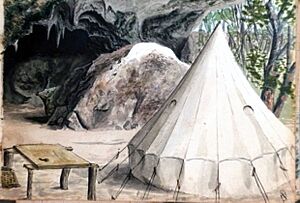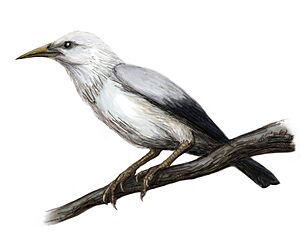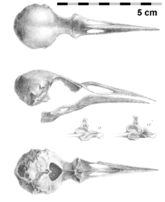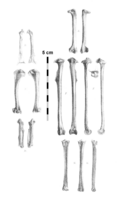Rodrigues starling facts for kids
Quick facts for kids Rodrigues starling |
|
|---|---|
 |
|
| The lectotype skull and other bones as depicted in the 1879 description | |
| Conservation status | |
| Scientific classification | |
| Genus: |
Necropsar
|
| Species: |
rodericanus
|
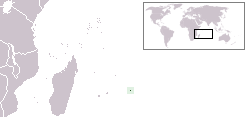 |
|
| Location of Rodrigues | |
| Synonyms | |
|
|
The Rodrigues starling (Necropsar rodericanus) was a type of starling bird that is now extinct. It lived only on the island of Rodrigues in the Mascarenes. Its closest relatives were the Mauritius starling and the hoopoe starling, both also extinct. These birds likely came from Southeast Asia.
A French sailor named Julien Tafforet first reported seeing this bird. He was stranded on Rodrigues from 1725 to 1726. Tafforet saw the bird on a small island nearby called Île Gombrani. Later, in 1879, scientists found subfossil bones on the main island. They believed these bones belonged to the bird Tafforet described. The Rodrigues starling was about 25–30 centimeters (10–12 inches) long. It had a strong beak. People described it as having a white body, black parts on its wings and tail, and yellow beak and legs.
Not much is known about how it lived. It ate eggs and dead tortoises, using its strong beak to break them open. Sadly, rats were brought to the island by humans. These rats likely caused the bird's extinction in the 18th century. The Rodrigues starling disappeared from the main island first. Then, it vanished from Île Gombrani, its last safe place.
Contents
Discovering the Rodrigues Starling
In 1725, a French sailor named Julien Tafforet was stuck on the island of Rodrigues for nine months. He wrote a report about his time there. In his report, he described many local animals. One was a white and black bird that ate eggs and dead tortoises. Tafforet said this bird only lived on a small island called Île Gombrani.
Another Frenchman, François Leguat, had also been stranded on Rodrigues earlier. He wrote about many species but did not have a boat. So, he could not explore the small islands nearby. Later visitors to Rodrigues did not mention seeing this bird. In 1875, a British bird expert, Alfred Newton, tried to figure out what bird Tafforet had seen. He thought it might be related to the extinct hoopoe starling from nearby Réunion island.
The first subfossil bones of a starling-like bird were found on Rodrigues. George Jenner found some in 1866 and 1871. Then, Henry H. Slater found more in 1874. These bones were found in caves on Plaine Coral, a flat area in southwest Rodrigues. The bones included parts of the skull, jaw, chest, wings, and legs. They were sent to museums in Britain.
In 1879, bird experts Albert Günther and Edward Newton (Alfred's brother) scientifically described the bird using these bones. They named it Necropsar rodericanus. Nekros and psar are Greek words meaning "dead" and "starling." Rodericanus refers to Rodrigues island. Günther and Newton believed the Rodrigues starling was closely related to the hoopoe starling. They thought the strong beak meant it was the same bird Tafforet had described.
In 2014, a British scientist named Julian P. Hume described a new extinct species. This was the Mauritius starling (Cryptopsar ischyrhynchus). He used subfossils found on Mauritius. It turned out to be more closely related to the Rodrigues starling than to the hoopoe starling.
Mistakes in Identifying the Bird
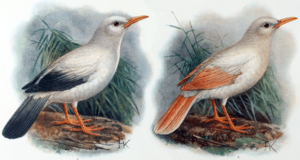
Over the years, there were some mix-ups about the Rodrigues starling. In 1898, Henry Ogg Forbes described a second species of Necropsar. He called it N. leguati. This was based on a bird skin from a museum that was labeled as coming from Madagascar. He thought this was the bird Tafforet saw, not the one from Rodrigues.
Later, in 2005, DNA tests showed that this museum specimen was actually an albinistic (all-white) grey trembler. This bird lives on the island of Martinique.
Some scientists also thought that the bird Tafforet described could not be a starling. This was because of its meat-eating habits. They thought it might be a type of chough, a bird related to crows. In 1937, one scientist even named it Testudophaga bicolor, meaning "tortoise eater." However, today, most bird experts agree that Tafforet's bird was indeed the Rodrigues starling.
How the Rodrigues Starling Evolved
Scientists believe that starlings like the Rodrigues starling came to the Mascarene islands from Asia. The Bali myna and the white-headed starling from East Asia look similar to these extinct birds. It seems there might have been two separate times when starlings arrived in the Mascarenes from Asia. The Rodrigues and Mauritius starlings are more closely related to each other. The hoopoe starling seems to be closer to Southeast Asian starlings.
The Mascarene islands were the only islands in the southwest Indian Ocean, besides Madagascar, that had native starlings. This is likely because these islands were isolated. They also had different types of land and plants.
What the Rodrigues Starling Looked Like
The Rodrigues starling was a large starling, about 25–30 centimeters (10–12 inches) long. Its body was white or grayish-white. Its wings were blackish-brown, and its beak and legs were yellow.
Here is what Tafforet wrote about the bird:
A little bird is found which is not common, for it is not found on the mainland. One sees it on the islet au Mât [Ile Gombrani], which is to the south of the main island, and I believe it keeps to that islet on account of the birds of prey which are on the mainland, as also to feed with more facility on the eggs of the fishing birds which feed there, for they feed on nothing else but eggs or turtles dead of hunger, which they well know how to tear out of their shells. These birds are a little larger than a blackbird, and have white plumage, part of the wings and tail black, the beak yellow as well as the feet, and make a wonderful warbling. I say a warbling, since they have many and altogether different notes. We brought up some with cooked meat, cut up very small, which they eat in preference to seed.
Tafforet knew the birds of Réunion, where the related hoopoe starling lived. He compared animals from different places. The fact that he did not mention a crest on the Rodrigues starling means it probably did not have one.
The skull of the Rodrigues starling was similar in size to the hoopoe starling's. However, its skeleton was smaller. The Rodrigues starling could clearly fly. But its breastbone was smaller than other starlings'. This might mean it did not need to fly powerfully. Rodrigues is a small island with varied land.
The two starlings were different mainly in their skulls, jaws, and breastbones. The Rodrigues starling's upper beak was shorter and stronger. Not enough bones have been found to know if males and females looked different. There are some size differences in the bones found. This could be due to individual variation. There are also differences in beak length and shape. This might suggest males and females had slightly different beaks.
The skull of the Rodrigues starling was flatter from top to bottom. It had a wide forehead bone. Its beak was about 36–39 mm (1.4–1.5 in) long. It was less curved and a bit deeper than the hoopoe starling's beak. The lower jaw was wide and sharp. It was also deep and strong at the back. This shows the starling had strong neck and jaw muscles.
The bones of its wings and legs were similar to other starlings. The thigh bone was large and strong. The lower leg bone was also large and strong. The ankle bone was long and robust.
Behaviour and Ecology
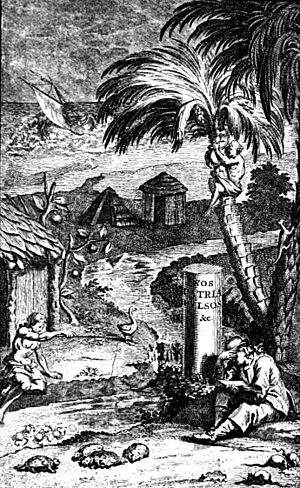
We know little about the Rodrigues starling's behaviour. Most information comes from Tafforet's description. Its strong legs and jaws suggest it looked for food on the ground. It probably ate snails and insects from Rodrigues. It also scavenged for food. Rodrigues had many seabirds and large land tortoises. There were also marine turtles. These would have provided a lot of food for the starling. This was especially true during breeding seasons.
Tafforet said that pigeons and parrots on the small islands only came to the mainland for water. Leguat noted that pigeons only nested on the small islands because of rats on the mainland. The starling might have done the same. Originally, the Rodrigues starling might have lived all over Rodrigues. It may have visited the small islands at certain times of the year. Tafforet also said the bird had a complex and beautiful song.
The Rodrigues starling's stronger, more bent jaw suggests it used more force when looking for food. It probably could remove objects and force open entrances. It did this by inserting its wedge-shaped beak and opening its jaws. Other starlings and crows do this. This ability supports Tafforet's observation that the bird ate eggs and dead tortoises. It could have torn young turtles and tortoises out of their shells. Tafforet did not see any Rodrigues starlings on the mainland. But he said they could be raised by feeding them meat. This means he likely brought young birds from Île Gombrani. Tafforet was on Rodrigues during the summer. He was able to get young birds. Some other Rodrigues birds breed at this time. So, the starling likely did too.
Many other species unique to Rodrigues became extinct after humans arrived. The island's natural environment is now very damaged. Before humans, forests covered the whole island. Very little forest remains today. The Rodrigues starling lived alongside other birds that are now extinct. These include the Rodrigues solitaire, the Rodrigues parrot, and the Rodrigues rail. Extinct reptiles include the domed Rodrigues giant tortoise and the saddle-backed Rodrigues giant tortoise.
Extinction of the Rodrigues Starling
Leguat mentioned that pigeons only bred on small islands off Rodrigues. This was because of rats on the main island. This might be why Tafforet only saw the Rodrigues starling on a small island. By Tafforet's visit in 1726, the bird was probably gone or very rare on mainland Rodrigues.
Rats are an invasive species. They might have arrived in 1601. This was when a Dutch fleet explored Rodrigues. The small islands would have been the bird's last safe place. But then, rats likely reached those islands too. The Rodrigues starling was extinct by the time a French scientist visited Rodrigues in 1761.
Many tortoises and marine turtles were exported from Rodrigues. This led to thousands of animals being removed. Cats were brought in to control the rats. But the cats also attacked the native birds and tortoises. The Rodrigues starling was already extinct on the mainland by then. Rats are good at crossing water. They live on almost all the small islands off Rodrigues today. At least five species of Aplonis starlings have become extinct on Pacific Ocean islands. Rats also helped cause their disappearance.



